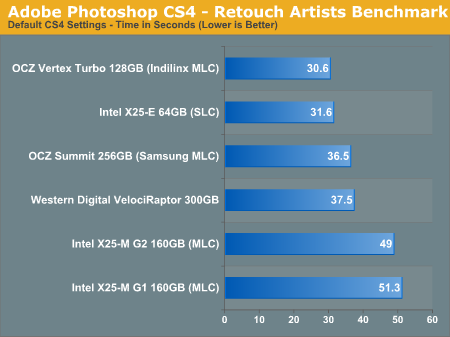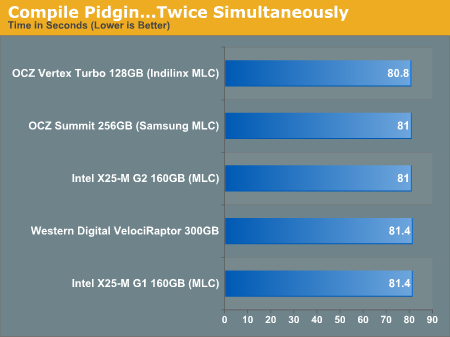The SSD Relapse: Understanding and Choosing the Best SSD
by Anand Lal Shimpi on August 30, 2009 12:00 AM EST- Posted in
- Storage
Individual Application Performance
PCMark Vantage does a great job of summarizing system performance, but I thought I'd pick a couple of applications to showcase real world strengths/weaknesses of these drives.
The first test is our Photoshop CS4 benchmark by the Retouch Artists. I made one small change to the way this test is run however. Normally I set the number of history states in Photoshop to 1, this significantly reduces the impact of the HDD/SSD on the test and makes it a better measure of CPU/memory speed. Since this is an SSD article, I've left the setting at its default value of 20. The numbers are now a lot lower and the performance a lot more disk bound.

I didn't run all of the drives through this test, just one from each major controller. The results speak for themselves. The Indilinx drives are actually the fastest MLC drives here. Even the Samsung is faster than the Intel drives in this test. Why? Sequential write speed. Even the VelociRaptor has a higher sequential write speed than the X25-M. So while sequential write speed isn't the most important metric to look at when evaluating an SSD, there are real world situations where it does matter.
Intel's performance here is just embarassing. Sequential write speed is something Intel needs to take more seriously in the future. Throw in any amount of random read/write operations alongside your Photoshop usage and the Intel drives would redeem themselves, but this is a very realistic snapshot of their achilles' heel.
Many of you have been asking for compiler benchmarks so I did just that. I grabbed the latest source for Pidgin (a popular IM application) and followed the developer's instructions on building it in Windows:

Nada. I thought perhaps it wasn't stressful enough so I tried building two instances in parallel:

And...nothing. It seems that building Pidgin is more CPU than IO bound, or at least its IO access isn't random enough to really benefit from an SSD. I'll keep experimenting with other compiler tests but this one appears to be a bust for SSD/HDD performance testing.










295 Comments
View All Comments
nemitech - Monday, August 31, 2009 - link
opps - not ebay - it was NEWEGG.Loki726 - Monday, August 31, 2009 - link
Thanks a ton for including the pidgin compiler benchmarks. I didn't think that HD performance would make much of a difference (linking large builds might be a different story), but it is great to have numbers to back up that intuition. Keep it up.torsteinowich - Monday, August 31, 2009 - link
HiYou write that the Indilinx wiper tool collects a free page list from the OS, then wipes the pages. This sounds like a dangerous operation to me since the OS might allocate some of these blocks after the tool collects the list, but before they are wiped.
Have you received a good explanation for Indilinx about how they ensure file system integrity? As far as i know Windows cannot temporarily switch to read-only mode on an active file system (at least not the system drive). The only way i could see this tool working safely would be by booting off a different media and accessing the file system to be trimmed offline with a tool that correctly identifies the unused pages for the particular file system being used. I could be wrong of course, maybe windows 7 has a system call to temporarily freeze FS writes, but i doubt it.
has407 - Monday, August 31, 2009 - link
It: (1) creates a large temporary file (wiper.dat) which gobbles up all (or most) of the free space; (2) determines the LBA's occupied by that file; (3) tells the SSD to TRIM those LBA's; and then (4) deletes the temporary file (wiper.date).From the OS/filesystem perspective, it's just another app and another file. (A similar technique is used by, e.g., sysinternals Windows SDelete app to zero free space. For Windows you could also probably use the hooks used by defrag utilities to accomplis it, but that would be a lot more work.)
cghebert - Monday, August 31, 2009 - link
Anand,Great article. Once again you have outclassed pretty much every other site out there with the depth of content in this review. You should start marketing t-shirts that say "Everything I learned about SSDs I learned from AnandTech"
I did have a question about gaming benchmarks, since you made this statement:
" but as you'll see later on in my gaming tests the benefits of an SSD really vary depending on the game"
But I never saw any gaming benchmarks. Did I miss something?
nafhan - Monday, August 31, 2009 - link
Just wanted to say awesome review.I've been reading Anandtech since 2000, and while other sites have gone downhill or (apparently) succumbed to pressure from advertisers, you guys have continued to give in depth, critical reviews.
I also appreciate that you do some real analysis instead of just throwing 10 pages of charts online.
Thanks, and keep up the good work!
zysurge - Monday, August 31, 2009 - link
Awesome amazing article. So much information, presented clearly.Question, though? I have an Intel G2 160GB drive coming in the next few days for my Dell D830 laptop, which will be running Windows 7 x64.
Do I set the controller to ATA and use the Intel Matrix driver, or set it to AHCI and use Microsoft's driver? Will either provide an advantage? I realize neither will provide TRIM until Q4, but after the firmware update, both should, right?
Thanks in advance!
ggathagan - Wednesday, September 16, 2009 - link
From page 15 (Early Trim support...):Under Windows 7 that means you have to use a Microsoft made IDE or AHCI driver (you can't install chipset drivers from anyone else).
Mumrik - Monday, August 31, 2009 - link
but I can't live with less than 300GB on that drive, and SSDs in usable sizes still cost more than high end video cards :-(I really hope I'll be able to pick up a 300GB drive for 100-200 bucks in a year or so, but it is probably a bit too optimistic.
Simen1 - Monday, August 31, 2009 - link
This is simply wrong. Ask anyone over 10 years if they think this mathematical statement is true or false. 80 can never equal 74,5.Now, someone claims that 1 GB = 10^9 B and others claim that 1 GB is 2^30 B. Who is really right? What does the G and the B mean? Who defines that?
The answers is easy to find and document. B means Byte. G stands for Giga ans means 10^6, not 2^30. Giga is defined in the international system of units, SI.
No standardization organization have _ever_ defined Giga to be 2^30. But IEC, International Electrotechnical Commission, have defined "Gi" to 2^30. This is supposed to be used for digital storage so people wont be confused by all the misunderstandings around this. Misunderstandings that mainly comes from Microsoft and quite a few other big software vendors. Companies that ignore the mathematical errors in their software when they claim that 80GB = 74,5 GB, and ignore both international standards on how to shorten large numbers.